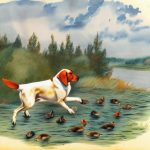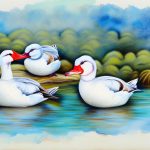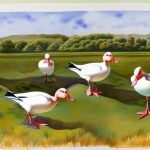Ducks are not only adorable and entertaining animals, but they also serve a variety of purposes on a farm or homestead. Whether you are looking for a pet, a source of eggs, or a natural pest control solution, there is a duck breed that can meet your needs. Nice duck breeds come in a wide range of sizes, colors, and temperaments, making it easy to find the perfect fit for your lifestyle and goals. In this article, we will explore some popular and rare duck breeds, their characteristics, care requirements, breeding and raising tips, as well as their various utilizations.
Table of Contents
- 1 Popular Nice Duck Breeds for Beginners
- 2 Rare and Unique Nice Duck Breeds
- 3 Characteristics and Care of Nice Duck Breeds
- 4 Breeding and Raising Nice Duck Breeds
- 5 Utilization of Nice Duck Breeds
- 6 Conclusion and Final Thoughts on Nice Duck Breeds
- 7 FAQs
- 7.1 What are some popular duck breeds?
- 7.2 What are the characteristics of Pekin ducks?
- 7.3 What are the characteristics of Mallard ducks?
- 7.4 What are the characteristics of Rouen ducks?
- 7.5 What are the characteristics of Khaki Campbell ducks?
- 7.6 What are the characteristics of Indian Runner ducks?
Key Takeaways
- Nice duck breeds come in a variety of colors, sizes, and temperaments, making them a popular choice for backyard enthusiasts and hobby farmers.
- Popular nice duck breeds for beginners include the Pekin, Khaki Campbell, and Indian Runner, known for their friendly nature and high egg production.
- Rare and unique nice duck breeds such as the Silver Appleyard, Saxony, and Cayuga offer a distinctive appearance and are sought after by collectors and breeders.
- Characteristics and care of nice duck breeds include providing a suitable living environment, balanced nutrition, and regular health checks to ensure their well-being.
- Breeding and raising nice duck breeds can be a rewarding experience, requiring proper knowledge of mating, egg incubation, and chick rearing for successful reproduction and growth.
Popular Nice Duck Breeds for Beginners
1. Pekin Ducks: Pekin ducks are one of the most popular duck breeds for beginners due to their friendly and calm nature. They are large, white ducks with orange bills and feet, making them easily recognizable. Pekins are excellent egg layers, producing large white eggs regularly. They are also known for their delicious meat, making them a dual-purpose breed. Pekin ducks are easy to care for and can thrive in various environments, making them an ideal choice for beginners.
2. Khaki Campbell Ducks: Khaki Campbell ducks are another popular choice for beginners, especially for those interested in egg production. These ducks are excellent layers, often producing over 300 eggs per year. They have a khaki-colored plumage and are known for their active and curious personalities. Khaki Campbells are relatively low-maintenance and can adapt well to different living conditions, making them a great addition to any backyard flock.
Rare and Unique Nice Duck Breeds
1. Silver Appleyard Ducks: Silver Appleyard ducks are a rare and unique breed known for their stunning plumage and friendly disposition. They are medium-sized ducks with beautiful silver and white feathers, making them a visually striking addition to any flock. Silver Appleyards are dual-purpose ducks, valued for both their egg-laying abilities and flavorful meat. While they may be harder to find than more common breeds, their unique appearance and excellent qualities make them a worthwhile addition to any duck enthusiast’s collection.
2. Saxony Ducks: Saxony ducks are another rare breed that is prized for its beauty and utility. They have a striking appearance with their blue-gray plumage and white bibs, making them stand out in any flock. Saxony ducks are known for their excellent egg-laying abilities, often producing around 200-250 large white eggs per year. They are also valued for their flavorful meat, making them a versatile breed for small-scale farmers and homesteaders. While Saxony ducks may be harder to come by, their unique combination of beauty and productivity makes them a valuable addition to any duck enthusiast’s flock.
Characteristics and Care of Nice Duck Breeds
When it comes to caring for nice duck breeds, there are several key characteristics and care requirements to consider. Ducks are social animals that thrive in the company of others, so it’s important to keep them in pairs or small groups to ensure their well-being. Additionally, ducks require access to water for bathing and drinking, as well as ample space to roam and forage. Providing a balanced diet that includes commercial duck feed, fresh greens, and access to insects and other natural foods is essential for maintaining their health and productivity.
Nice duck breeds also require protection from predators and the elements, so providing a secure coop or shelter is crucial. Regular health checks and preventative measures for common duck ailments such as bumblefoot and respiratory infections are also important for maintaining the well-being of your flock. Overall, nice duck breeds are relatively low-maintenance animals that can thrive with proper care and attention.
Breeding and Raising Nice Duck Breeds
Breeding and raising nice duck breeds can be a rewarding experience for both hobbyists and small-scale farmers. When it comes to breeding ducks, it’s important to provide a suitable nesting area with plenty of clean bedding material to encourage broody hens to lay and incubate their eggs. Duck eggs typically take around 28 days to hatch, so it’s important to provide a warm and secure environment for the eggs during this time.
Once the ducklings hatch, they will require a warm brooder area with access to food and water to ensure their health and growth. It’s important to provide a balanced diet specifically formulated for ducklings to support their rapid growth and development. As the ducklings mature, they can be gradually introduced to the outdoor environment under supervision until they are ready to join the adult flock.
Utilization of Nice Duck Breeds

Nice duck breeds offer a wide range of utilizations beyond just being adorable pets. Ducks are excellent natural pest control agents, as they eagerly consume insects, slugs, snails, and other garden pests. This makes them a valuable addition to any garden or farm seeking natural pest control solutions without the use of harmful chemicals.
Additionally, many nice duck breeds are valued for their egg-laying abilities, producing delicious and nutritious eggs that can be enjoyed by the whole family. Duck eggs are often prized for their rich flavor and larger size compared to chicken eggs, making them a popular choice for baking and cooking enthusiasts.
Furthermore, nice duck breeds such as Pekin ducks and Muscovy ducks are also valued for their flavorful meat, providing a sustainable source of protein for small-scale farmers and homesteaders. Duck meat is known for its rich flavor and versatility in various culinary dishes, making it a valuable addition to any self-sufficient lifestyle.
Conclusion and Final Thoughts on Nice Duck Breeds
In conclusion, nice duck breeds offer a wide range of benefits for both beginners and experienced poultry enthusiasts alike. Whether you are looking for friendly pets, prolific egg layers, natural pest control solutions, or a sustainable source of meat, there is a duck breed that can meet your needs. With proper care and attention, nice duck breeds can thrive in various environments and provide valuable contributions to any homestead or farm.
From popular breeds like Pekin ducks and Khaki Campbell ducks to rare and unique breeds like Silver Appleyard ducks and Saxony ducks, there is no shortage of options when it comes to selecting the perfect duck breed for your lifestyle and goals. Whether you are interested in raising ducks for their eggs, meat, or simply as entertaining companions, there is a nice duck breed that can fulfill your desires and bring joy to your life. With their charming personalities, beautiful plumage, and valuable contributions, nice duck breeds are truly a delightful addition to any farm or homestead setting.
If you’re interested in learning more about raising ducks, you might also want to check out Poultry Wizard’s article on “Can Geese Eat Chicken Feed?” This informative piece delves into the dietary needs of geese and provides valuable insights for poultry enthusiasts. Whether you’re considering adding geese to your flock or simply want to expand your knowledge of poultry care, this article offers practical advice and useful tips. (source)
FAQs
What are some popular duck breeds?
Some popular duck breeds include the Pekin, Mallard, Rouen, Khaki Campbell, and Indian Runner.
What are the characteristics of Pekin ducks?
Pekin ducks are known for their white feathers, orange bills, and calm temperament. They are also a popular choice for meat production.
What are the characteristics of Mallard ducks?
Mallard ducks are known for their colorful plumage, with the males having a distinct green head. They are also a common wild duck species.
What are the characteristics of Rouen ducks?
Rouen ducks are similar in appearance to Mallards, but they are larger and heavier. They have a calm disposition and are often raised for meat.
What are the characteristics of Khaki Campbell ducks?
Khaki Campbell ducks are known for their khaki-colored feathers and prolific egg-laying abilities. They are a popular choice for egg production.
What are the characteristics of Indian Runner ducks?
Indian Runner ducks are known for their upright posture and distinctive “runner” gait. They are good layers and are often used for pest control in gardens.
Meet Walter, the feathered-friend fanatic of Florida! Nestled in the sunshine state, Walter struts through life with his feathered companions, clucking his way to happiness. With a coop that’s fancier than a five-star hotel, he’s the Don Juan of the chicken world. When he’s not teaching his hens to do the cha-cha, you’ll find him in a heated debate with his prized rooster, Sir Clucks-a-Lot. Walter’s poultry passion is no yolk; he’s the sunny-side-up guy you never knew you needed in your flock of friends!







